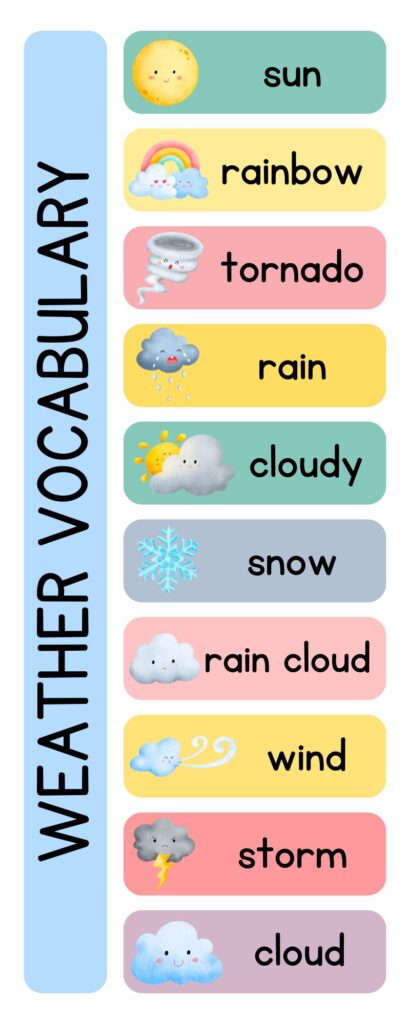Imagine your child weaving tales filled with colorful descriptions, confidently expressing themselves, and tackling complex ideas with ease. That’s the power of a rich vocabulary!
As a parent, you hold the key to unlocking this magic. This guide is your treasure map, packed with engaging ways to turn everyday moments into vocabulary-building adventures.
Let’s transform your home into a language laboratory where every conversation becomes a springboard for exploration!
Vocabulary is a matter of word-building as well as word-using.
David Crystal
Table of Contents
The Playground of Everyday Talk
You’re your child’s personal language superhero! Every interaction, from bedtime stories to grocery runs, is a chance to expand their word bank. Here’s how to turn these moments into mini-vocabulary quests:
- Level Up Descriptions: Instead of a simple “big dog,” say, “Wow! Look at that enormous Great Dane! Its fur is like a patchwork of brown and white! Can you think of another word for ‘big’?” This encourages them to use synonyms and explore descriptive language.
- Labeling Adventures: Turn daily routines into naming games. “This spoon is smooth and shiny like a mirror. Can you pass me the wooden cutting board? What else might we call a cutting board?” This reinforces object recognition and introduces new vocabulary.
- Thesaurus Time: When your child uses a familiar word, introduce synonyms. Feeling “happy”? Maybe they’re also “joyful” or “elated.” Feeling “sad”? Explore “gloomy” or “downcast.”
Ask! “What other words can you think of to describe how you’re feeling?” prompts them to think creatively.
Reading: A Magical Voyage of Words
Books are portals to endless vocabularies! Here are some tips to make story time a word fiesta:
Reading is an important way for children to learn vocabulary as they are more likely to come across new words in written language than they will hear in spoken language. Encourage your child to read widely and also read aloud to them, even when they can read on their own.
Oxford University Press
- Mix it Up: Explore different books! Dive into fantasy, delve into mysteries, or soar through space – each genre introduces new words and ideas.
- Don’t shy away from “big” words: Briefly explain them in the context of the story without derailing the adventure.
Stop and Ask! “We just read about a ‘majestic’ castle. What do you think ‘majestic’ means?” - Act it Out!: Bring stories to life by dramatizing scenes. Encourage your child to use descriptive language while acting out their favorite characters.
Challenge! “Can you describe the dragon’s roar using a really powerful word?” - Revisit Old Friends: Rereading favorites allows children to absorb new words with each encounter. They’ll be surprised at how much they understand as their vocabulary grows!
Learning Through Play: Games Galore!
Learning shouldn’t feel like homework. Let’s make it a blast with learning through play:
- Word Chain Challenge: Take turns saying words that connect to the previous one. This sparks creativity and expands their word arsenal.
Make it Silly! Throw in some funny or nonsense words to keep things light. - Storytelling Charades: Act out a story together, taking turns describing scenes and characters with vivid language.
Bonus Challenge! Try acting out a story without using any words at all, then see if your child can guess it using descriptive phrases. - “I Spy” with a Twist: Instead of just saying the color, have them describe the object: “I spy with my little eye something long and green that helps you write.”
Level Up! Once they describe the object, ask them to use a word in a sentence with that object. - Board Game Bonanza: Choose word-based games like Scrabble or Boggle. Even simple games like Candyland can be vocabulary exercises by describing the colors and actions on the board.
Make it Interactive! Have them create their own silly game rules that involve using new vocabulary.
Tech Time: A Wise Ally
Educational apps and websites can be helpful tools, but remember, they shouldn’t replace the magic of traditional methods. Here’s how to use them wisely:
- Interactive E-books: Look for apps with features that highlight words and provide child-friendly definitions.
Ask! “This book says ‘gigantic’ means very big. Can you think of another way to say gigantic?” - Educational Apps: Opt for apps that promote vocabulary learning through engaging games and activities that cater to your child’s age and learning style.
Explore Together! Play the app with your child and discuss the new words they’re learning.
- Learning Websites: Websites with interactive stories, quizzes, and puzzles can provide extra practice in a fun format.
Challenge! Can you find a website that teaches vocabulary words about your child’s favorite topic?
Remember:
- Consistency is key: Regular exposure to new words leads to vocabulary mastery. Aim to incorporate these activities into your daily routine, even if it’s just for a few minutes.
- Laughter is the best medicine: Make learning fun and celebrate their efforts, no matter how small. When they use a new word correctly, give them a big high five or create a silly handshake to commemorate the achievement.
- Be a vocabulary role model: Use a rich vocabulary in your everyday conversations. Talk about your day using descriptive language, and don’t be afraid to use those “big” words yourself!
- Don’t be afraid to goof around!: Make up silly words together, create funny word chains, or write nonsensical stories. Laughter is a powerful learning tool that can make vocabulary-building enjoyable for everyone.
By incorporating these strategies, you can transform your home into a language-rich haven.
Remember, fostering a love for words is a gift that keeps on giving. Watch your child blossom into a confident communicator, a master storyteller, and a lifelong learner!
Age-Appropriate Activities

Here are some additional tips for tailoring vocabulary-building activities to your child’s specific age group:
- Toddlers (1-3 years old): Focus on basic nouns, verbs, and adjectives. Sing songs, read simple picture books, and narrate your daily activities using descriptive language. Play matching games and object-sorting activities to reinforce word recognition.
Between 36-48 months, vocabulary begins to be more related to quality. It’s important to provide a child with narratives, speak about past and future events, and use sophisticated language with examples so they can learn to understand new words based on descriptions related to words they already know.
JCFS, Jody B. Miller, MA, CCC-SLP
- Preschoolers (3-5 years old): Introduce more complex vocabulary and sentence structures. Engage in pretend play and encourage them to describe their actions and feelings. Play word games like rhyming games or “I spy” to build critical thinking skills. Read books with longer storylines and discuss the characters and plot.
Frequently Asked Questions
-
When do children start building their vocabulary?
It’s amazing how early vocabulary development begins! Even before babies can speak their first “mama” or “dada,” they’re busy soaking up the world around them. By 6 months old, they might understand many words you use frequently, even if they can’t quite say them back. Then, around the first birthday mark, the magic of babbling kicks in, followed by those first exciting spoken words between 12 and 18 months. From there, it’s a vocabulary explosion!
-
My 2-year-old doesn’t seem to have many words. Should I be worried?
Every child develops at their own pace, and language skills are no exception. If you’re concerned about your 2-year-old’s vocabulary, talking to your pediatrician is always a good idea. They can assess your child’s hearing and overall development to rule out any underlying issues.
Here are some things to keep an eye on:
– Does your little one understand simple requests like “pick up your toys” or “come here”?
– Do they babble or use sounds that seem like they’re trying to communicate?
– Are they curious about sounds and words, reaching out to touch books or pointing at objects?
If you answered yes to these, it’s a positive sign that your child’s language skills are on the right track. -
What’s the biggest secret to building a strong vocabulary?
There isn’t one magic trick, but consistent exposure to language is key. The more your child hears and interacts with words, the faster their vocabulary will blossom. Here are some ways you can be a language superhero for your little one:
Chat it up! Every conversation, from singing silly songs to narrating your day, exposes them to new words.
Books are best friends! Reading together is a fantastic way to introduce rich vocabulary in a fun and engaging way. Pointing to pictures and asking questions helps them connect words to the story.
Respond to their babbling! When you respond to their sounds and gestures, you show them that communication is important and encourage them to keep exploring the world of words. -
How does a child’s vocabulary actually grow?
Vocabulary development is a fascinating journey that happens in stages. Here’s a simplified glimpse:
Early babbling: Around 6 months, those adorable “ba-ba” and “da-da” sounds erupt. While not quite words yet, they’re the building blocks for future language skills.
First words: Between 1 and 1.5 years old, most children start using their first words, usually simple nouns like “mama” or “food.”
Two-word wonders: By 18-24 months, get ready for those adorable two-word phrases like “go bye” or “more milk.”
Vocabulary boom!: Between 2 and 3 years old, hold on tight! Children’s vocabulary explodes as they learn new words every week and start using more complex grammar.
Refining communication skills: From age 3 onwards, the journey continues. Children keep learning new words and understanding language nuances. They become more articulate and can express themselves in increasingly complex ways.













